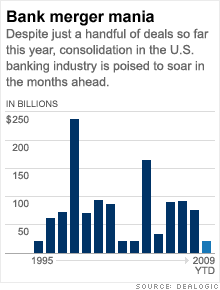For small banks, it's eat or get eaten
Squeezed by rising loan losses and a need for more capital, some lenders may have little choice but to pair up with rivals.

NEW YORK (CNNMoney.com) -- Don't look now, but the nation's banking industry is about to get a whole lot smaller.
Even after last year's mega deals, including the acquisitions of Wachovia and Washington Mutual, experts are predicting a robust period of mergers that should consolidate the industry even further.
At last count, there were close to 8,300 banking organizations across the country, according to the Federal Deposit Insurance Corp. While that is down nearly 10% from the number of banks just five years ago, many experts contend that more mergers will be necessary, especially among smaller banks.
"There are some market forces that are working in favor of another round of M&A," said Khanh Vuong, a vice president in the banking group at rating agency A.M. Best.
Presently, lenders of all types find themselves overwhelmed by loan losses. Earlier this month, federal regulators demanded that 10 of the nation's largest 19 financial institutions raise a combined $75 billion in new capital to deal with potential losses if the economy deteriorates further.
Most of these leading institutions have been able to quickly exploit investors' renewed appetite for banks by selling stock in recent weeks. Many regional and community banks, however, are finding it difficult to undertake similar capital-raising efforts.
That, combined with the fact that many banks are now trading at historically low levels, suggest that it could be only a matter of time before some of these smaller banks look to pair up in order to remain competitive.
After Lehman Brothers went bust last fall, there was an almost unprecedented succession of mega deals in the weeks that followed.
First, there was Bank of America's (BAC, Fortune 500) controversial purchase of brokerage giant Merrill Lynch, which was announced just as Lehman filed for bankruptcy.
Less than two weeks later, JPMorgan Chase (JPM, Fortune 500) scooped up the banking assets of beleaguered savings-and-loan giant Washington Mutual. Wells Fargo's (WFC, Fortune 500) purchase of Wachovia soon followed, as did PNC's (PNC, Fortune 500) acquisition of Ohio-based regional banking giant National City.
But as active as the banking merger market was at the end of last year, the pace and value of deals paled in comparison to what took place in the late 1990s or in 2004, the last time many major banks went on a major shopping spree.
Last year, there were 203 bank takeovers, according to research firm Dealogic. Those deals were worth approximately $77 billion. But more than 430 bank mergers worth $236 billion worth took place in 1998, and there were 270 deals totaling $165 billion in 2004.
Many of those tie-ups were done at a time when banks were healthy and looking to expand. That's hardly the case now. William W. Lang, senior vice president in the department of supervision, regulation and credit at the Federal Reserve Bank of Philadelphia, said the imminent thinning of the current banking herd will happen largely out of a need for survival.
Along those lines, it's more likely that small and mid-sized banks will pair up with each other instead of already big banks looking to get even larger.
Kent Carstater, managing director in the financial institutions group at Stifel Nicolaus, said banks that overextended themselves to keep up with loan demand may try to merge with lenders that have a lot of capital, but not a lot of room to grow.
"There is a natural medium here for those guys to get together," he said. "If they can figure out the [corporate culture] issues, both can win."
What is strikingly unclear however, is when a new wave of bank deals will start. So far this year, there haven't been any blockbuster bank mergers, suggesting that the appetite among the biggest lenders for more deals has tapered off.
In addition, experts point to a number of uncertainties that continue to swirl around the industry, including the direction of the nation's economy, as obstacles to more mergers.
With unemployment on the rise and losses in credit card and commercial real estate portfolios on the upswing, bankers may pause for a quarter or two before gobbling up a rival due to fears of absorbing another institution's problems.
Some ailing lenders that are potential takeover targets, on the other hand, may believe that they are strong enough to weather the economy after bolstering their loan loss reserves in recent quarters, notes Stifel's Carstater.
There are also a variety of government assistance programs that still remain available to smaller banks, including the Treasury Department's Troubled Asset Relief Program and the FDIC's debt-guarantee program, which could help some firms remain independent.
"A lot of banks feel they are in a position to outrun the problem," said Carstater.
One key wild card in all of this will be whether the government allows big banks to participate in the consolidation process.
The air of desperation that was evident last fall following the collapse of Lehman Brothers played a key role in the subsequent industry mergers. But that sense of impending doom has largely dissipated given the recent rally in bank stocks.
At the same time, a number of leading regulators, including FDIC chairman Sheila Bair, have publicly expressed their reluctance to allow more sprawling financial institutions to be created that could face the risk of having to be bailed out by taxpayers in the future. ![]()

